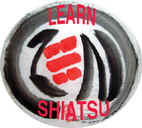Anatomy Physiology & Pathology Assignment:
SKELETAL system (why blue?)

|
HEALTH WARNING: THIS IS ONE OF THE BIGGER ASSIGNMENTS so, pleeeeze, understand that spending more than 3 hours on it will be a great temptation BUT don't let it damage your enthusiasm. In the early stages of learning you might not get much done in 3 hours but do have patience with yourself. It will come. Remember that bones are the only crystalline substances in our bodies and with the properties of crystals - they can receive vibrational transmissions. The more you know about bones, the more you will understand, and the more effective your treatments. A friend asks you if shiatsu can help with: Osteoarthritis What are the symptoms and organic changes of their condition? What tsubos might help relieve their symptoms? What do you think might be the underlying elemental imbalance? What related organ/meridian network governs this anatomical system? What might be the related or local meridians, and why do you think so? Would you describe the condition as more kyo or more jitsu? What might be your treatment approach? How would you explain to your friend this condition in terms of energy-flow and elemental imbalances? What suggestions/recommendations might you make if your friend asks how they could share in their own healing – for example, life-style, diet, habits, exercise, meditation, other therapies? How would your responses differ for other conditions of the same system, and should any be contra-indicated? why do you think so? Rheumatoid arthritis, Rheumatism, Osteoporosis, Kyphosis, Scoliosis, Lordosis, Rickets, Ankylosing spondylitis, Gout What are the main functions of the skeletal system? How might Shiatsu affect this system? Describe the locations of the following bones (9), meridians running across or along (7) and any tsubos on the bone: zygomatic, frontal, parietal, temporal, sphenoid, nasal, mandible, maxillae, occipital, 7 cervical vertebrae, 12 thoracic vertebrae, 5 lumbar vertebrae, 9 (false - why?) sacral vertebrae, sternum, xiphoid process, 12 pairs of ribs, clavicles, scapulae, humerus, radius, ulnar, carpals, metacarpals, phalanges, ilium, ischium, pubis, femur, tibia, fibula, patella, tarsals, metatarsals, phalanges, Who or what are ASIS and PSIS and where does PSOAS phit in? What connects bones to muscles? What connects bones to bones? Where is SI11 and what is it good for? Where is the Wind of Heaven? What flares between ST36 and SP9? SummaryThe Intermediate Diploma Assessment Requirement is for you to be able to explain, in everyday language as if to a friend with no knowledge of anatomy, the four following aspects of this system:
For Professional Licence Assessment you may be asked to explain anything from this assignment using anatomical/medical terminology – “as if on the telephone to a Latin-speaking Doctor!” Module Completion: please have your Tutor validate the following ASSIGNMENT COMPLETED:__________________date & stamp TUTORIAL ATTENDED_______________________date & stamp PRACTICAL ATTENDED:_____________________date & stamp LEARNING-TREATMENTS...........................attach for stamping What have you learned about yourself from this Assignment? |